Lecture 11 lexical cohesion 英语词汇学 教学课件
Lexical-ApproachPPT课件

Page 2
BACKGROUND
Belief : The building blocks of language learning and communication are not grammar, functions, notions, or some other unit of planning and teaching but lexis.
Page 13
语料库在英语词汇教学中的应用
用于词汇大纲设计与教材词汇编写 用于词汇用法教学 用于词汇搭配教学 用语词汇分布教学
解决了‘教什么’的问题 解决了‘怎么教’的问题
High-frequency lexical items should be learnt first. Create an environment in which students can discover lexical chunks by themselves.
Advantages
lexical approach can enhance accuracy and fluency of language production.
Lexical approach can deepen learners’ understanding of language rules.
Pawley & Syder: Native speakers have hundreds of prepackaged phrases.
Krashen :“language input” is realized by reading.
Page 8
Bahns :The teaching of lexical collocations should center on items. Lewis : It lacks a coherent learning theory.
lecture VIII

Lecture VIII: Lexical cohesion and textual coherence
1. 张大嫂有个女儿。男尊女卑的思想在中国尚未 彻底消除。中国正在实现四个现代化。后现代主 义是一种文学思潮。 这段话中有词汇衔接手段,如:“女儿”、男、 女;中国、中国;现代化、后现代等,且尽管每 句话表达了一定的意义,但作为整个语篇,意思 是不连贯的,说话人在语篇中究竟要表达什么中 心思想不得而知。 2. A: Would you like to go to cinema this evening? B: I have a test tomorrow. 3. A. How did you like the performance? B. It was a nice theatre.
Passage 2
…… 1991 年,本世纪最多事的年份之一, 世界目睹了卫星现场直播电视对这些事件 所产生的影响,连新闻定义本身也被改写 了——从已发生的事改为收看电视时正在 发生着的事。…… …… 这些全世界都听到都看到的枪声,是在第 一家全球性电视新闻公司、即有线新闻电 视公司 (CNN) 的主持下出现的。……
Lecture VIII: Lexical cohesion and textual coherence
II. the relationship between lexical cohesion and textual coherence 1. Cohesion is the foundation of coherence. 2. Lexical cohesion provides a basis for coherence, and meanwhile it is governed by coherence. In general, lexical cohesion could lead to coherence. However, sometimes, a text with lexical cohesion is not necessarily coherent, and a text without lexical coherence is logically coherent. e.g.
2011级(2013)词汇学演示文稿10
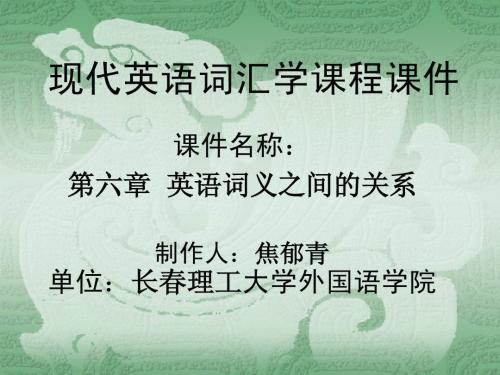
同义词是发音和拼写不同, 但在意义上相似或完全相
★
Synonymy is a term used in semantics to refer to a synonymous relation between semantic elements. 同义关系是指具体语言中语义构成成份完全 相同或大部分相同的关系。
★
They can not be substituted in all the styles due to different formal degree and emotional colouring.
3) Dominant synonym主导同义词
Dominant synonym: Such as, discover is dominant synonym among
2) Relative synonyms相对同义词
What are the similarity and differences among the
words? E.g. father (formal), daddy (oral), pdenote different shades of meaning or different degrees of a given quality are called relative synonyms. (partial synonymy) E.g. look, see, watch, observe;
⑴Norman conquered Britain in 1066
⑵Modern Time
First, after Norman conquered Britain in
⑴ Norman conquered Britain in 1066
Lecture1《英语词汇学》第一章教案

Lecture1《英语词汇学》第一章教案Self IntroductionName: ZHENG JiaqinProfessional tile: Associate ProfessorAcademic degree: Bachelor?s degreeCellular phone: 135********E-mail:jiaqinzheng1966@/doc/9510006114.html, Ways of MarkingClassroom attendance20%Assignments 20%Final test60%Text Book:《现代英语词汇学概论》张韵斐主编,北京师范大学出版社,2004-10出版◆R eference books:1. 《现代英语词汇学》-新版(陆国强, 2002, 上海:上海外语教育出版社)2.《英语词汇学教程》(汪榕培,卢晓娟,1997,上海: 上海外语教育出版社)Leture 1讲授题目:1. A Brief Introduction to the Course---English Lexicology2. The Development ofEnglish Vocabulary所属章节:《现代英语词汇学概论》第1章计划学时:2 periods教学方法:传统讲授法参考资料:《英语词汇学教程》、《英语词汇学》教学目的和要求:通过本单元的学习,学生对英语词汇学的研究对象、性质、特点以及英语语言的发展进程等基本知识有了一定的了解。
IntroductionWhat is linguistics?Generally speaking, linguistics can be defined as the scientificstudy of language. To be more exact, linguistics studies the general principles upon which all human languages areconstructed and operate as systems of human communication.LEXICOLOGY1.The term lexicology contains two Greek morphemes: “lexikon”and “logie”; the former means “word or phrase”, while the latter “learning or the study of”.2. The literal meaning is the “science of the word”.3. It is the study of the signification/meaning and application/uses of words.4. Lexicology is a branch of linguistics inquiring into the origins and meanings of words ( WNWD-Webster?s New World Dictionary of the American Language ).THE FIVE SUB-BRANCHES OF LEXICOLOGY 1.Semantics: the study of the meanings of words and other parts of language.2.Etymology: studies the meanings, origin and history of individual words and their development.3. Historical lexicology: studies from a historical point of viewthe development of vocabulary4. Phraseology(成语学): mainly deals with set expressionsand idioms.5. Lexicography: studies the writing and making ofdictionaries.English lexicologyEnglish lexicology deals with English words, their origin, meaning, morphological structures, semantic structures, sense relations , idioms, historical development, formation and usages.The Nature of English LexicologyEnglish lexicology is a theoretically-oriented course. It is chiefly concerned with the basic theories of words in general and of English words in particular. However, it is a practical course as well, for in the discussion, we shall inevitably deal with copious stocks of words and idioms, and many usages examples. Naturally, there will be a large quantity of practice involved.THE AIMS OF THIS COURSEOffer an insight into the origin and development of the Englishvocabulary.Give a systematic description of the English vocabulary.Discuss the problems of word-structure and word-formation Study the use of English words , their meanings and changes in meaning, their sense relations.THE SIGNIFICANCE OF THE COURSEDevelop your personal vocabulary and consciously increase your wordpower (active vocabulary).Understand word-meaning and organize, classify and store words moreeffectively.Raise your awareness of meaning and usages, use words more accurately and appropriately.Develop your skills and habits of analyzing and generalizinglinguisticphenomena in your learning experiences.Ultimately improve your receptive and productive skills in languageprocessing as well as language production.TWO APPROACHES TO THE STUDY OF ENGLISHLEXICOLOGYA synchronic approach is an approach to the study of a language at one period of time,A diachronic approach is an approach to the study of the change in a language that took place over a period of time.There are two approaches to the study of words, namely synchronic and diachronic. From a synchronic point of view, words can be studied at a point in time, disregarding whatever changes might be taking place. For example the word …wife? now means ……a married woman, esp. in relation to her husband??. This is the current meaning.It has an obsolete meaning …woman?, which is only preserved in midwife, housewife, Bathwife, etc. However if we take a diachronic perspective, we will consider the word historically, looking into its origin and changes in form and meaning. In this light, the word …wife? evolved from the old English … wif ?, meaning … woman?, but later it became specialized in the course of development to the modern meaning …a married woman?.TWO APPROACHES TO THE STUDY OF ENGLISHLEXICOLOGYModern linguistics is mainly synchronic, focusing on the present-day language (English words), but we need the diachronic approach as a supplement, for a knowledge ofhistorical development of the vocabulary will definitely be of great help to us in our language study.Questions and Tasks1. What is lexicology?2. What is the nature and scope of English lexicology?3. Why should a student of English study English lexicology?。
lexical cohesion 例子
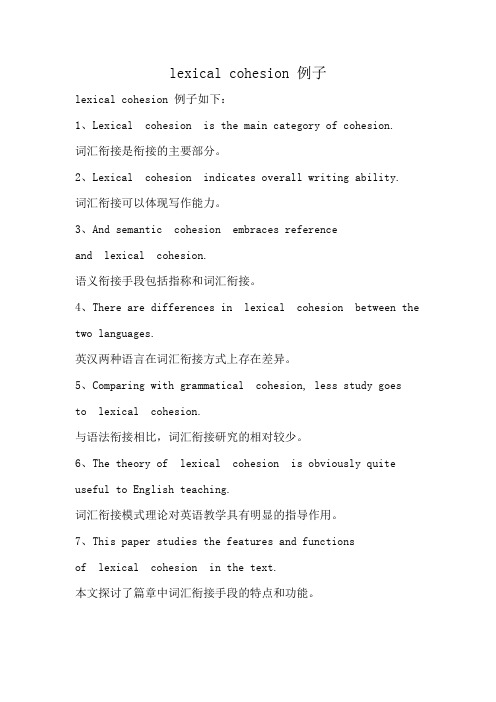
lexical cohesion 例子lexical cohesion 例子如下:1、Lexical cohesion is the main category of cohesion.词汇衔接是衔接的主要部分。
2、Lexical cohesion indicates overall writing ability.词汇衔接可以体现写作能力。
3、And semantic cohesion embraces referenceand lexical cohesion.语义衔接手段包括指称和词汇衔接。
4、There are differences in lexical cohesion between the two languages.英汉两种语言在词汇衔接方式上存在差异。
5、Comparing with grammatical cohesion, less study goesto lexical cohesion.与语法衔接相比,词汇衔接研究的相对较少。
6、The theory of lexical cohesion is obviously quite useful to English teaching.词汇衔接模式理论对英语教学具有明显的指导作用。
7、This paper studies the features and functionsof lexical cohesion in the text.本文探讨了篇章中词汇衔接手段的特点和功能。
8、Lexical cohesion is an important cohesive device to cohere a business English text.词汇衔接是实现语篇连贯的重要衔接机制之一。
9、Lexical cohesion plays an important part in the realization of discourse coherence.词汇衔接是实现语篇连贯的重要手段。
Lecture 11 lexical cohesion 英语词汇学 教学课件
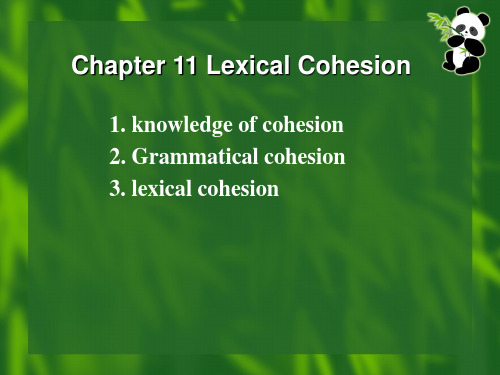
endophora(指内)
What is exophora?
❖ It is also called exophoric reference or situation reference, referring to an item whose referent is retrievable in the context of situation.
Task 1 Brainstorming
❖ _______ but he couldn’t keep her
❖ Please help make a complete sentence with the part mentioned above
❖ Peter had a wife but he couldn’t keep her
❖ There are two main types of cohesion: grammatical, referring to the structural content, and lexical, referring to the language content of the piece. A cohesive text is created in many different ways. In Cohesion in English, Halliday and Hasan identify five general categories of cohesive devices that create coherence in texts: reference, ellipsis, substitution, lexical cohesion, and conjunction.
Lecture 12 cohesion andcoherence 英语词汇学 教学课件
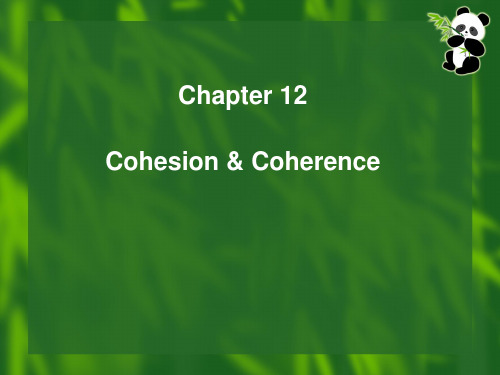
Conjunctions
Conjuncts have a fundamental role in the cohesion of a text and may have various functions
Listing (indicating that what follows is a list of propositions) To start with, First, Second, Third
Chapter 12 Cohesion & Coherence
Revision Causes for Meaning Change in Words
1. Historical 2. Social 3. Psychological 4. linguistic
Pencil”, for instance, is from a Latin word meaning “a little tail” or “a fine brush”, like our Chinese “pen”. Later, when it was made of wood and graphite, it was still called a “pencil”. “Engine” originates in Latin word “ingenium, natural ability”. But when stream power was developed in the first quarter of the 19th century, the term “engine” comes to mean “a railroad locomotive”, and in contemporary English it means “any machine that uses energy to develop mechanical power, esp., a machine for starting motion in some other machine”
英语词汇学授课课件 PPT
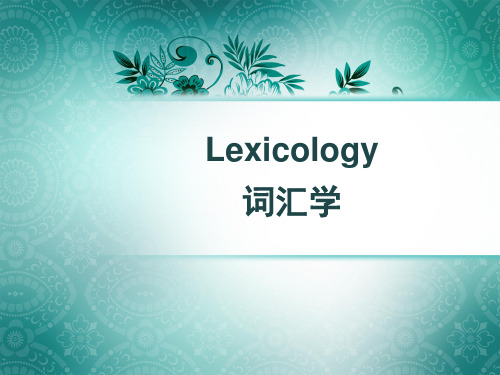
B: rapid growth of present-day English Vocabulary and Its causes
❖ Neologisms(新词) after World War II ❖ Reasons: ❖ 1. progress of science and technology科技
❖ This definition emphasizes syntax(句法), but does not touch upon meaning.
Antoine Meillet
❖ “A word is defined by the association of a given sense with a given group of sounds capable of a given grammatical use.” (p.2, para.2 )
Bloomfield布洛姆菲尔德(美国语言学家教育 家) and ❖ a French linguist, Antoine Meillet(梅耶,法 国语言学家)
Bloomfield
❖ “some linguistic forms(语言形态), which we call bound forms(限定/非自由形态) are never used as sentences.
invaded by Angles盎格鲁, Saxons撒克逊, Jutes朱特人
❖ Vocabulary: 5000-6000 words,chiefly Anglo-Saxon/ some Old Norse古斯堪的那维 亚语
❖ Old Norse words (are, they, their, them, till, call, die, give, take, skin, window, ill, weak)
现代英语词汇学
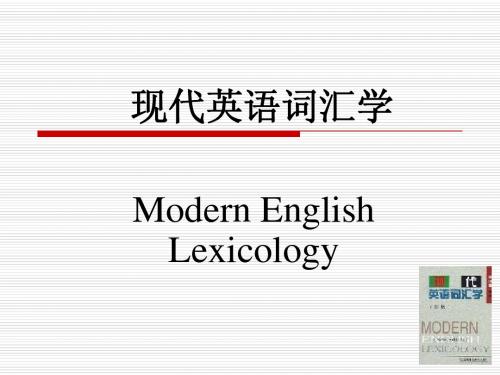
Chapter 11: Lexical Cohesion
3. 上坐标词:Great music has always required patronage. Bach had the Lutheran church. Haydn had Prince Esterhazy. Even Tchaikovsky had Madame von Meck. Today’s great musicians have the Toyota Corporation, which since 1990 has sponsored Toyota Classics, an innovative and ambitious program designed to bring the masterpiece of classical music to audiences across Asia. The idea behind it is simple: to present the finest of today’s performers in concert---with all proceeds going to charity---as Toyota’s way of saying thank you to its loyal customer base of more than thirty years. In the seven years since the program’s inception(初衷), nearly 70000 people have attended 54 concerts, with a total of nearly $2 million going to local charities.
Lecture 11 American English

Lecture 11
4
11.1 English as an international
language
Users of English
English as a native language: Britain, the United States, Ireland, Australia, New Zealand, Canada, the West Indies and South Africa.
American English or British English?
Lecture 11
2
Questions
What is American English? Is it American English or British English we are speaking as
non-native speakers? Is there essential difference between British English and
Lecture 11511.1 English as an international language
Varieties of English
Lecture10-《英语词汇学》第10章教案
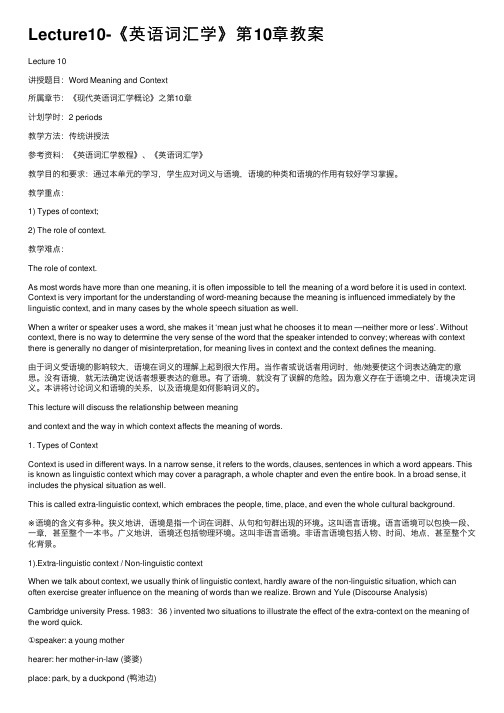
Lecture10-《英语词汇学》第10章教案Lecture 10讲授题⽬:Word Meaning and Context所属章节:《现代英语词汇学概论》之第10章计划学时:2 periods教学⽅法:传统讲授法参考资料:《英语词汇学教程》、《英语词汇学》教学⽬的和要求:通过本单元的学习,学⽣应对词义与语境,语境的种类和语境的作⽤有较好学习掌握。
教学重点:1) Types of context;2) The role of context.教学难点:The role of context.As most words have more than one meaning, it is often impossible to tell the meaning of a word before it is used in context. Context is very important for the understanding of word-meaning because the meaning is influenced immediately by the linguistic context, and in many cases by the whole speech situation as well.When a writer or speaker uses a word, she makes it ‘mean just what he chooses it to mean —neither more or less’. Without context, there is no way to determine the very sense of the word that the speaker intended to convey; whereas with context there is generally no danger of misinterpretation, for meaning lives in context and the context defines the meaning.由于词义受语境的影响较⼤,语境在词义的理解上起到很⼤作⽤。
lecture VII

Lexical cohesion: reiteration (repetition)
3. super-ordinates. E.g. (1). Marian had dreams of becoming a musician, a folksinger. (2).He wished for the thousandth time in his life that he had a dog, a golden retriever, maybe, for travels like this and to keep him company at home. -----from The Bridges of Madison County
] Lecture inition of cohesion II. Types of cohesion (1) grammatical cohesion (2) lexical cohesion A. reiteration B. collocation
More examples
(1)There were children everywhere. There were children on the swing, children in the slides, and children on the merry-go-round. (2) The committee suggested that all sexist language be removed from the regulations. If this suggestion is adopted, we shall have to avoid “he”, “his”, etc. 1). Children—children—children 2). Suggested--suggestion
Cohesion语言学衔接教学课件讲议

Reference
We can illustrate reference with the following diagram:
Reference
[situational] exophora
[textual] endophora
[to preceding text] [to following text]
a) This is the house that Jack built. b) Algy met a bear. The bear was bulgy. The bulge was Algy.
Demonstrative Reference
In a) we know which ‘house’ is being referred to, because we are told-it is the one built by Jack; and notice that the information comes after the occurrence of the the. In b) we know which bearthe one that Algy met; and we know which bulgethe one displayed by the bear; but in this case the information had already been given before the the occurred.
Lecture11lexicalcohesion英语词汇学教学课件
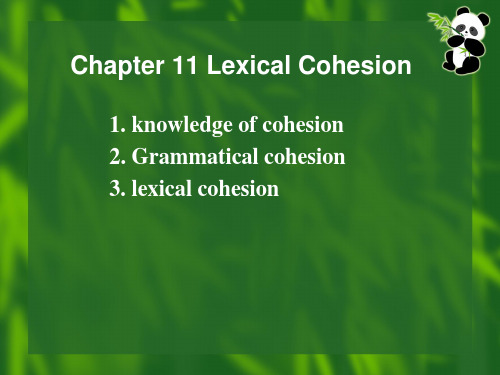
❖ Cataphora refers to an item whose referent can be retrieved within the succeeding part of the text.
❖
It is generally accepted that revolves around the sun.
the
ceaatrtahphora
❖ Do you want to have another biscuit?
exophora
❖ Secondly the grammatical device worth mentioning here is ellipsis and substitution.
❖ Here, cohesive ties refer to one occurrence of a pair of cohesively related items, the single instance of cohesion.
❖ Three blind mice, three blind mice.
❖ Ellipsis refers to the omission of an item and substitution refers to the replacement of one item by another.
❖ Task 4 discussion
❖ Why do we often adopt ellipsis and substitution in writing and speaking?
《词汇学》英文版课件Chapter 1 English Lexicology--Introduction

Teaching focus:
1.1 What Is a Word
a minimal free form of a language a sound unit a unit of meaning a form that can function alone in a sentence “A word is a minimal free form of a language that has a given sound and meaning and syntactic function”. 词是具有一定的声音、意义和语法功能,能独 立运用的最小的语言单位。
Morphology studies the structures or forms of words through the use of morpheme construct Etymology studies the origins and history of the form and meaning of words. Semantics studies the meanings of words and sense relations: polysemy,homonymy,synonymy,antonomy, hyponmy, and semantic field
• 1.2 Sound and Meaning • There is no logical or intrinsic connection between a sound and what it refers to. The relation between sound and meaning is almost always arbitrary or conventional. The same language can use the same sound to mean different things and the different languages use different sounds to refer to the same thing.
Lecture 7-《英语词汇学》第七章教案讲稿

Lecture 7讲授题目:Word Meaning所属章节:《现代英语词汇学概论》之第5章计划学时:2 periods教学方法:传统讲授法参考资料:《英语词汇学教程》、《英语词汇学》教学目的和要求:通过本单元的学习,让学生对词的意义、词义的理据和词义的类别等知识有基本的了解和认识。
教学重点:①Some basic notions: meaning , reference, concept and motivation;②Semantic triangle;③Four types of motivations④Classification of word meaning教学难点:①Four types of motivations②Classification of word meaningWord meaningThe relationship between language and the world conceptworld languageWord meaningThought or reference (concept)ReferentSymbol(object in the world) (word, sentence ) Ogden & Richards‟ the semiotic triangleThe semantic triangleAccording to Ogden and Richards, the symbol is the linguistic element, that is the word ,sentence ,etc., and the referent is the object,etc. , in the world of existence, while thought or reference is concept. This is called the semantic triangle.奥德根和理查德提出的“语义三角”的基本观点是:概念、思想和符号(即字词)发生直接联系,而与“所指客体/事物”(即现实世界和人的经历)并不存在直接联系。
英语词汇学教程课件第1章English Lexicology 1
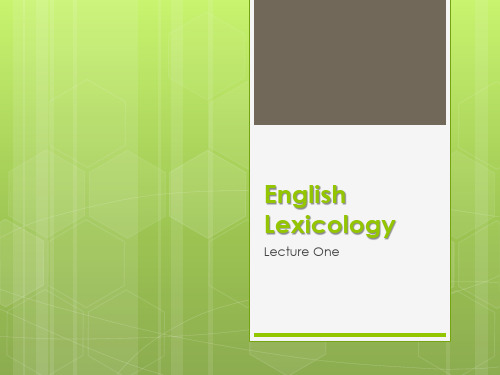
Lexicography involves the writing and compilation of dictionaries, especially dealing with the principles that underlie the process of compiling and editing dictionaries.
a new waste paper basket
The second type of definition considers the word as a thought unit or a psychological unit.
Farmer Rethink Spoonful all of a sudden as usual.
Semantics
Semantics studies meaning. It is usually approached from one of two perspectives: philosophical or linguistic.
Philosophical semantics is concerned with the logical properties of lanபைடு நூலகம்uage, the nature of formal theories, and the language of logic.
Linguistic semantics involves all aspects of meaning in natural languages, from the meaning of complex utterances in specific context to that of individual sounds in syllables.
- 1、下载文档前请自行甄别文档内容的完整性,平台不提供额外的编辑、内容补充、找答案等附加服务。
- 2、"仅部分预览"的文档,不可在线预览部分如存在完整性等问题,可反馈申请退款(可完整预览的文档不适用该条件!)。
- 3、如文档侵犯您的权益,请联系客服反馈,我们会尽快为您处理(人工客服工作时间:9:00-18:30)。
❖ Moreover, it is sometimes believed that the omitted part is not inside the text but outside the text, in context.
❖ Glad to meet you! ❖ Haven’t heard from you for a long time ❖ What is omitted?
❖ He came. He saw. He conquered. ❖ He died. He didn’t see the sum of money
❖ It is often accepted that there is a major reason as follows:
❖ As far as pragmatic motivation is concerned, substitution and ellipsis are both motivated by the economy principle. Human beings are apt to use the minimum and most effortless possible linguistic units in the process of communication so that they can convey the maximum possible information with the minimum possible effort.
❖ Ellipsis refers to the omission of an item and substitution refers to the replacement of one item by another.
❖ Task 4 discussion
❖ Why do we often adopt ellipsis and substitution in writing and speaking?
❖ It is clear that wife and her are in the relation of cohesive ties.
❖ Cohesive ties may be either grammatical devices such reference, ellipsis, and substitution, and conjunction, or lexical devices such as general words, reiteration and collocation.
❖ It should be noted that anaphora refers to an item whose referent is retrievable in the preceding part of the text.
❖ Cataphora refers to an item whose referent can be retrieved within the succeeding part of the text.
❖ For instance,
❖ Can you see that man over there?
❖ I would like to take this
❖ Task 2 analyze
❖ Who does “that man, I” refer to ?
❖ What does “this” refer to?
k 1 Brainstorming
❖ _______ but he couldn’t keep her
❖ Please help make a complete sentence with the part mentioned above
❖ Peter had a wife but he couldn’t keep her
❖ --Do you like New York?
❖ --Yes, I do.
❖ Clausal substitution refers to the replacement of a noun clause by using so,not
❖ --Is John coming to the evening party?
❖ He died, for he didn’t see the car coming ❖ In that case, he would have taken a taxi. ❖ The weather was appalling. But we had a
pleasant time.
Ex.
❖ It should be however pointed out that there are some different cases
❖ The referents can not be found inside the sentences but in the context outside the text.
What is endophora?
❖ It refers to an item whose referent can be retrieved within the text. Endophora can be further divided into two subcategories: anaphora(前指) and cataphora (后指)
❖ Task 3 seeking out
❖ Please seek out what category they belong to.
❖ One has to do his duties anaphora
❖ Listen to this: John’s getting married
cataphora
❖ --I hope so/I hope not
conjunction
❖ Conjunction in grammar refers to a word or expression like and, but, or , in that case, for example, connecting words, phrases, clauses, and sentences with a certain logical relation.
substitution
❖ According to the elements substituted , there are three types of substitution:
❖ Nominal substitution ❖ Verbal substitution ❖ Clausal substitution
❖ A brief introduction will be given to grammatical devices while lexical devices should be introduced in detail.
Grammatical devices
❖ Reference refers to the semantic relations in which a word or words are used to enable the addressee to identify someone or something.
❖ Cohesion is the grammatical and lexical relationship within a text or sentence. Cohesion can be defined as the links that hold a text together and give it meaning. It is related to the broader concept of coherence, which will be elaborated in next lecture.
❖ Reference falls into two categories: ❖ They are exophora (指外) and
endophora(指内)
What is exophora?
❖ It is also called exophoric reference or situation reference, referring to an item whose referent is retrievable in the context of situation.
❖ Nominal substitution refers to the replacement of a noun.
❖ --I have lost my watch
❖ --Get a new one
❖ Verbal substitution refers to the substitution of a verb phrase.
Ellipsis
❖ It is usually noted that as for ellipsis, the omitted part can be found in the text
❖ --Did you see him yesterday? ❖ --Yes. ❖ What is omitted?
❖
It is generally accepted that revolves around the sun.
the
ceaatrtahphora
❖ Do you want to have another biscuit?
exophora
❖ Secondly the grammatical device worth mentioning here is ellipsis and substitution.
